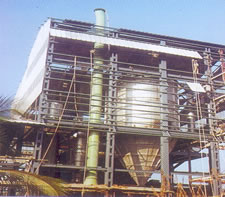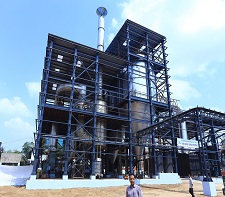-
Spray Dryers
-
Spray dryers are devices used in spray drying. It takes a liquid stream and separates the solute or suspension as a solid and the solvent into a vapor. The solid is usually collected in a drum or cyclone. The liquid input stream is sprayed through a nozzle into a hot vapor stream and porised. A nozzle is usually used to make the droplets as small as possible, maximising heat transfer and the rate of water vaporisation. Droplet sizes can range from 20 μm to 180 μm depending on the nozzle.
Spray dryers can dry a product very quickly compared to other methods of drying.
Spray Dryers are custom built designs having various atomization and flow patterns to suit the feed and product characteristics and can be used for drying of versatile range of products.
Spray Drying is a single step drying operation in which liquid feed solutions, emulsions, dispersions or slurries are directly converted to free flowing powder or granules. Read more about spray dryers and our services in relation to spray dryers below
-
Rotary Disc Atomisation
-

A high speed rotating disc is used for atomizing the liquid feed. The disc throws the liquid outward tangentially at high velocities forming fine droplets / mist by impacting with relatively slow moving hot air. Instant drying takes place due to extremely large surface area to volume ratio converting liquid/slurries into free flowing dry powder.
Discs designs include straight / curved vanes, pin wheels, multilayer discs in diameters of 60 mm, 100 mm, 160 mm, 250 mm & 350 mm for different capacities.
For high temperature applications special water cooled bearing arrangements are available.
-
Nozzle Atomisation
-
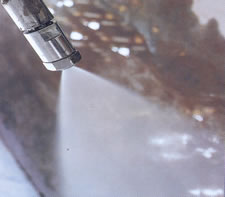
Feed solution or slurry at high pressure is atomized through a nozzle into fine droplets and then dried instantaneously. Various types of airflow patterns are possible with nozzle atomization systems. Nozzle type spray dryers are used to produce material in the granular, non-dusty or powder form as required.
Depending on the desired physical properties of end product, the choice of co-current, counter current or mixed air flow is selected.
Features
-
Wide range of materials can be dried
-
Options of both single fluid / two fluid nozzles
-
Easy to operate and user friendly
-
Compact layout
-
Automatic / remote nozzle change over with steam / air flushing
-
Explosion Vents, Fire Fighting Nozzles, Pressure Designs
-
Inert Atmosphere Drying
-
Closed Loop Spray Dryers
-
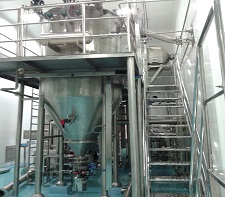
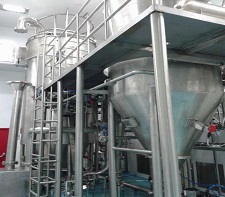
Closed loop spray dryers are used when the product to be dried is oxidisable or laden with flammable / explosive solvents, nitrogen purged. In this case, closed loop systems are preferred.
Advantages
-
Ideal for solvent laden, flammable / explosive product to be dried
-
Inert gas drying avoids oxidizing of material
-
Recovery of costly solvents
-
Air Broom & Wall Cooling
-
Wall cooling arrangements are provided on Spray Chambers handling products of thermoplastic nature. The arrangements include and external cooling air jacket and / or internal rotating arms with air jets to form AIr Bloom on the chamber wall.
Advantages
-
These Spray Dryers are ideal for thermoplastic, heat sensitive, hygroscopic products
-
Multi-stage Spray Dryers cum Granulators
-
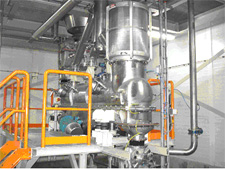
Spray Dryers with integrated Fluid Beds are ideally used to meet special particle size, dispersibility and bulk density requirements. The spray comes in contact with fluidized dried particles and agglomerates. External fluidized bed systems are provided for finish drying, de-dusting and product cooling.
Features
-
Suitable for production of granular, non-dusting, instantised or hygroscopic products
-
Design available for explosive / fire hazardous products
-
Energy efficient operation
-
Mini Spray Dryers
-
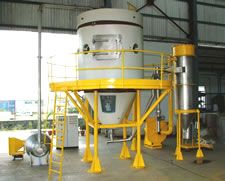
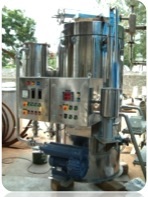
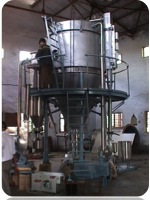
The Standard plant of Mini Spray dryers is complete with Electrical air heating system. Spray chamber, Cyclone separator, Bag filter, Air handling fans, Feed tank, Feed pump, Rotary atomizer, Operating panel, Instruments.
Spray dryers plants are available in Stainless Steels grade AISI 316 or AISI 304, for feed and product contract parts. Other materials can be offered on request. Let us look at the operational featuers of Mini Spray dryers.
Optional Features
-
Two fluid / Pressure Nozzle Atomiser for feed atomization
-
Oil / Gas fired air heating system, steam / Thermic fluid air heating system
-
Dehumidified internally rotating air broom arms for the products of thermoplastic nature
-
Closed loop system with inert gas drying for the product containing flammable / explosive solvents
-
Solvent recovery system
| Model |
Water Evaporation Capacity kg's/hr |
Inlet temperature °C |
Outlet temperature °C |
| MINI 5 |
5 |
250 |
100 |
| MINI 10 |
5 |
250 |
100 |
| MINI 15 |
15 |
250 |
100 |
| MINI 25 |
25 |
250 |
100 |
-
Fluid Bed Dryers
-
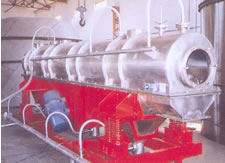
Fluid Bed Dryers are offered in static as well as Vibratory Design and are used for amorphous/ crystalline products with relatively close particle size distribution.
-
Vibratory Fluid Bed Dryers
-

Vibratory fluid bed dryers are used for amorphous/ crystalline powders which are difficult to fluidise. Air fluidisation is supplemented by mechanical vibrations to achieve uniform bed distribution on the perforated plate.
The dryer offers better control on fluidisation, residence time, product moisture and dust levels.
-
Adjustable residence times to suit each individual product
-
Uniform product temperature possible
-
Drying and cooling in a single step
-
Closed loop insert gas with solvent recovery system
-
CIP (Cleaning in Place) options
-
Static Fluid Bed Dryers
-
Static fluid bed dryers are used for crystalline powders which are easy to fluidise. Air fluidisation is possible due to fairly uniform particle size distribution.
-
Flash Dryers
-
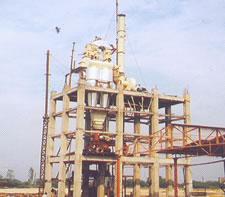
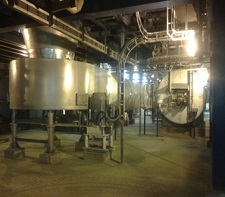
Flash Dryers are used for drying of wet cakes, crystals or granular products, sticky or non-sticky in nature. These are long ducts carrying hot air at a high velocity and the material is dried while it is pneumatically conveyed along with hot air.
Features
-
Adjustable residence times to suit each individual product
-
Uniform product temperature possible
-
Drying and cooling in a single step
-
Closed loop insert gas with solvent recovery system
-
CIP (Cleaning in Place) options
-
Cage Mill Flash Dryers
-
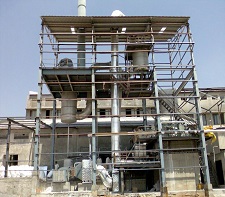
For lumpy materials size reduction is required to enhance the drying rate. These are ideally suited for such applications.
Features
-
Continuous operation & single step drying disintegration of dry hard product lumps or crusts
-
Particle size control
-
Recycling of hot gases for better thermal efficiency.
-
Agitated Flash Dryers
-
They are used when the material to be dried is sticky in nature, thixotropic and requires longer drying time
-
Continuous operation & single step drying of sticky cakes, pastes, sludges and semi-hard lumps
-
Dual action of drying in fluidized condition & size reduction
-
Uniform product quality due to automatic stepless feed & temperature control
-
Unique feeding device for constant product moisture
-
Incorporation of specially designed particle classifiers
-
Rotary Dryers
-

Rotary Dryers are rugged and robust in construction. The solids to be dried are showered in a hot stream of air and dried during travel through the dryer.
-
Direct Rotary Dryers
-
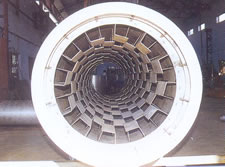
Direct Rotary Dryer comprises of a rotating inclined shell through which a hot stream of air flows. The wet material present in the rotary shell is lifted by means of spiral flights and showered in hot flowing air. Due to this direct contact, the product is dried.
Direct Rotary Dryer comprises of a rotating inclined shell through which a hot stream of air flows. The wet material present in the rotary shell is lifted by means of spiral flights and showered in hot flowing air. Due to this direct contact, the product is dried.
The internals are designed to ensure uniform distribution/showering over the entire cross section.
The entire shell is supported on rollers /tyres and rotated by means of girth gear or by means of a friction drive. Sealing arrangement are also provided so as to have a minimum air leakage and product/Thermal losses.
Features
-
Ideally suited for large capacity applications and uneven particle size distribution
-
Continuous operation and versatile application
-
Low operating & maintenance cost
-
Indirect Rotary Dryers
-
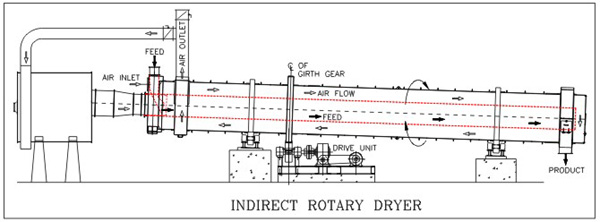
Indirect Rotary Dryers comprises of a rotating shell having a concentric inner shell. Hot products of combustion passed through the inner concentric shell not coming in contact with the product. The product is dried by radiation and conduction.
Advantages
-
Products which can get oxidised or flammable can be dried very easily.
-
Continuous operation and versatile application
-
Low operating & maintenance cost
-
Conduction Dryers
-
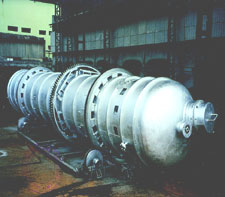
This range of dryers employ the conduction mode for drying. These dryers ensure low temperature, gentle drying of the product. Conduction dryers are designed taking into consideration the wet and dry product flow characteristics, lump crust formation tendency and thermal sensitivity of the product in dry condition.
-
Indirect Steam Tube Rotary Dryer
-
Indirect Steam Tube Rotary dryer comprises of tubes fixed to a rotating shell. Steam is passed through the tubes. The wet material present in the rotary shell is lifted by means of spiral flights and showered on the steam heated tubes. The product is dried by means of the indirect contact with steam. The entire shell is supported on rollers and rotated by means of girth gear.
The sealing arrangement is provided to have minimum air leakage and product losses.
Advantages
-
Rugged construction
-
Continuous operation
-
Gentle drying of material
-
Thermally efficient
-
Low operating & maintenance cost
-
Rotary Tube Bundle Dryers
-
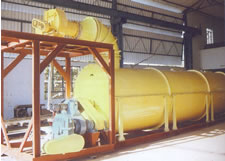
A Tube Bundle is like a heat exchanger, rotated in a stationary insulated housing. Lifters provided on the tube bundle lift the material and shower them on the hot tube bundle surface. Steam is passed from one end of Tube Bundle for drying and condensate is removed from the other end.
Advantages
-
Gentle drying
-
No breaking of material
-
High heat economy
-
Continuous operation
-
Vacuum Dryers
-
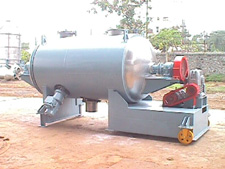
Vacuum dryers are used to facilitate rapid and low temperature drying of heat sensitive products without raising their temperature.
Features
-
Low temperature gentle drying.
-
Ideal for heat sensitive products
-
Minimum space required.
-
Solvent recovery.
-
Double Cone Rotary Vacuum Dryer
-
The Double Cone Vacuum Dryer is jacketed on the outside for steam / hot water heating. The double cone is rotated through a chain drive and vacuum is applied in the chamber through special rotary joints.
-
Cylindrical Rotary Vacuum Dryer
-
These dryers are cylindrical jacketed chambers and are equipped with a central shaft to which paddles or ribbons and scrappers can be attached for agitation and mixing.
Vacuum in drying chamber allows drying of internal at low temperature.
Features
-
Low temperature agitated vacuum drying.
-
Ideal for heat sensitive products, which can be agitated.
-
Minimum space required
-
Computational Fluid Dynamics (CFD)
-
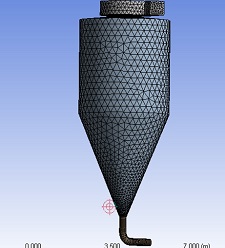
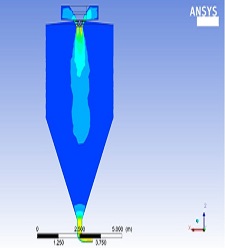
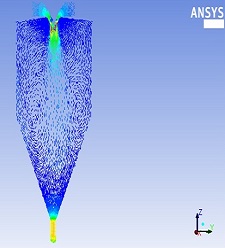
To make our customers realize their product potential right from conceptualization to make informed decisions, we need to rely on advanced design solutions to meet complex and competitive business environments.
At MOJJ,with our CFD based design optimisation we serve as an important link for our design team and manufacturing team to help realise product optimisation right from ideation to realization. We have successfully completed complex and critical projects by our CFD Team.
Our team collaborate together, to deliver solutions to our clients and create more value for the end customers. Our engineering facility is equipped with state-of-the-art hardware and leading professional CFD solvers, capable to handle large and complex geometries.
-
Multiphase Flow Analysis For Various Applications/Industries
-
Increasing complexity in dryers and mixing devices is posing challenges to manufacturers to evaluate conventional product testing methodologies.
Our CFD solutions for multiphase flow assists design engineers to optimize the design of equipments involving drying, mixing and separation of fluids present in multiple phases. With proper application of turbulence models and flow equations, our analysts helps in evaluating the performance of mixing or separation devices as well as predict the interaction between the solid and liquid or gas particles. The solution also helps engineers to visualize droplets and track particles without conducting experimental investigation.
Predicting particle size, trajectories, collision and breakup can provide key information to engineers with respect to the product design right from the initial design phase. Design can be modified against the simulation results predicting the particle deposition and growth rate due to obstacles in the design, allowing final design to remain flawless.
